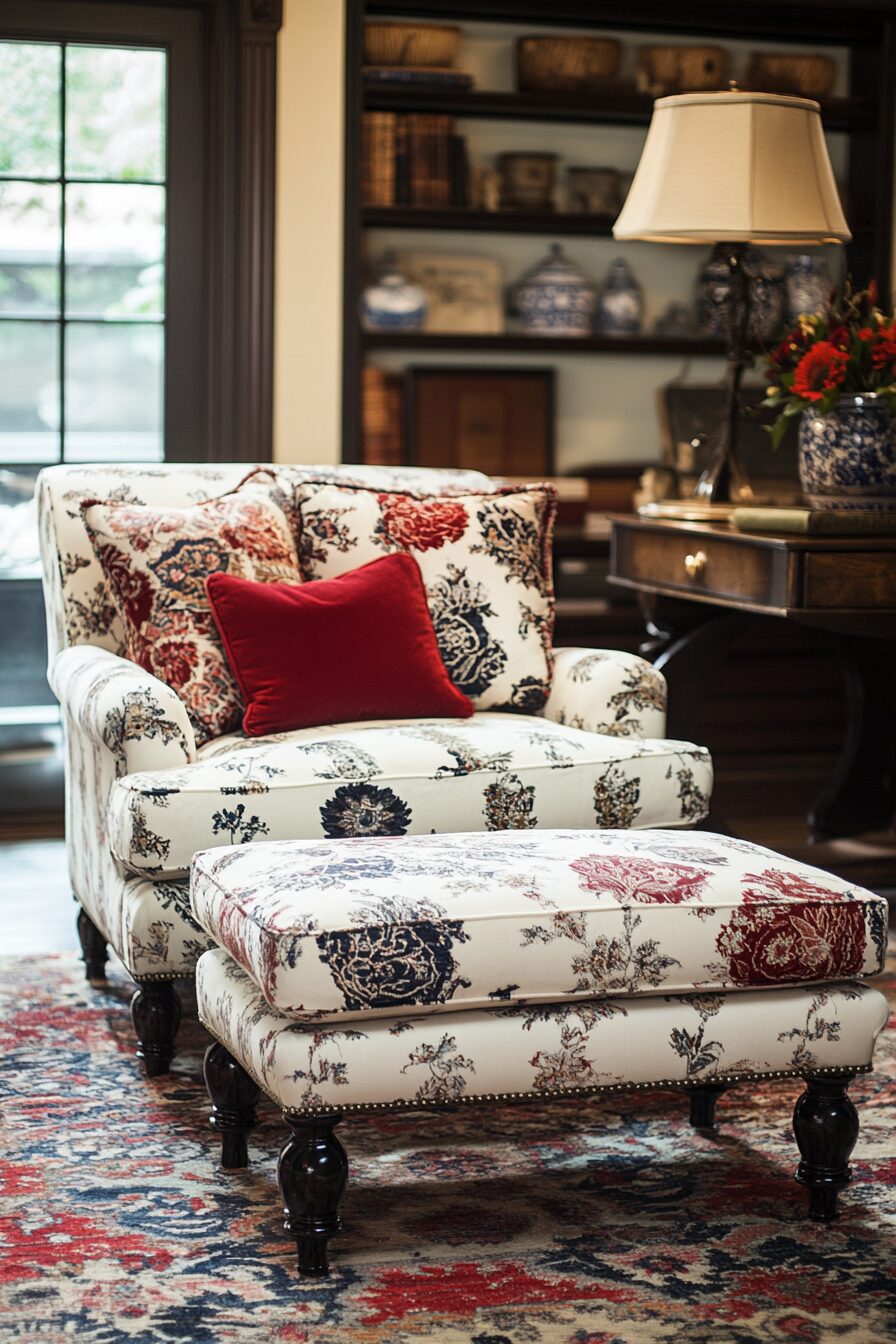Think sofas are the only way to create a comfortable living room?
Think again!
There are plenty of ways to design an inviting space without that bulky piece of furniture taking center stage.

Breaking free from the “must-have sofa” rule can actually open up a world of creative possibilities for your living area.
You might discover that your room feels more spacious, conversation flows more naturally, or your space better reflects your personal style when you ditch the conventional couch.
The best part?
My ideas work for spaces of all sizes, from tiny studio apartments to spacious family rooms
So Let’s Go:
✨Click to Get My 101 FREE Designer Room Ideas
Floor Cushions and Poufs for a Boho Paradise


Floor cushions and poufs create an instantly relaxed atmosphere that invites people to kick off their shoes and get comfortable.
This setup works amazingly well for casual gatherings, movie nights, or just lounging around with a good book.
The beauty of floor seating is its flexibility—you can easily rearrange cushions to accommodate different numbers of people or activities.
When guests leave, simply stack them in a corner to open up your floor space again.
For a cohesive look, choose cushions in complementary colors but mix up the textures and patterns to add visual interest.
Large floor pillows (24-36 inches) provide the most comfort for extended sitting, while smaller ones can serve as back supports.
To elevate this style, add a low coffee table in the center—think 12-18 inches high—that’s perfect for setting down drinks or playing board games.
Consider adding a few side tables at similar heights where people can place personal items or additional snacks.
A plush area rug underneath will add another layer of comfort and help define the seating area in open-concept spaces.
This approach works particularly well in bohemian, Moroccan, or globally-inspired décor schemes.
For back support, place some cushions against a wall or add a few floor backrests designed specifically for this purpose.
The informal nature of floor seating naturally encourages conversation and connection among friends and family.
In smaller spaces, floor cushions that double as storage containers give you places to stash blankets, magazines, or other living room essentials.
Comfy Armchairs for a Reading Nook Heaven


Creating a dedicated reading corner with two or three ultra-comfortable armchairs can transform your living space into a cozy retreat that rivals any sofa setup.
The key is selecting chairs that truly invite you to sink in and stay awhile—look for deep seats, padded arms, and supportive backs.
Wingback chairs offer a classic, sheltered feeling perfect for getting lost in a book, while oversized club chairs provide maximum lounging potential.
Positioning these chairs to face each other at a slight angle naturally creates a conversation area that feels intimate and inviting.
Add an ottoman that can serve triple-duty as a footrest, extra seating, and a place to set down a tray of snacks or drinks.
A small side table next to each chair gives everyone their own space for setting down reading materials, beverages, or personal items.
Lighting is crucial in this setup—consider a floor lamp behind each chair to provide perfect reading light without harsh overhead glare.
A bookshelf nearby not only provides storage for your reading material but also helps define the space and adds personality.
Choose chairs with washable slipcovers if you’re concerned about keeping light-colored fabrics clean over time.
Adding throws and pillows to each chair increases comfort while introducing additional textures and colors to your design scheme.
For maximum coziness, position your reading nook near a window where natural light streams in during the day.
This arrangement works surprisingly well for entertaining small groups, as the chairs naturally create a circle conducive to conversation.
In smaller spaces, chairs with a smaller footprint but generous seating area give you comfort without overwhelming the room.
This setup adapts beautifully to seasonal changes—swap out pillows and throws to refresh the space throughout the year.
Unlike a sofa that dominates a room, individual chairs can be easily moved around when you need to accommodate different activities.
Consider mixing chair styles for an eclectic, collected-over-time look that adds character to your space.
Daybed: The Ultimate Multitasking Marvel


A daybed offers the perfect compromise between sofa and bed, giving you a place to lounge during the day and sleep at night.
Unlike a traditional sofa, a daybed can be approached from three sides, making it more versatile in how you arrange your room.
Many daybeds include storage drawers underneath, providing valuable space for linens, seasonal items, or everyday necessities.
Styling a daybed is half the fun—layer it with different sized pillows against the wall to create a sofa-like experience during the day.
For maximum versatility, choose a daybed with a trundle underneath that can be pulled out when overnight guests arrive.
The flat, even surface of a daybed makes it more comfortable for actually sleeping than trying to spend the night on a typical sofa.
A daybed typically costs less than buying both a sofa and a guest bed separately, making it a budget-friendly choice for small spaces.
Position your daybed against a wall with windows to create a sunny reading spot that doubles as a guest room when needed.
Add a small rolling cart nearby that can function as both a bedside table and a place to set drinks when you’re using the daybed for seating.
For a cohesive look, choose daybed linens that complement your room’s color scheme rather than traditional bedding sets.
A daybed works particularly well in studio apartments or multi-purpose rooms where you need furniture to serve several functions.
Unlike a sofa bed with its sometimes-uncomfortable mechanism, a daybed provides consistent comfort whether used for sitting or sleeping.
The higher seating position of most daybeds makes them easier to get in and out of for people with mobility concerns.
Add sconces on the wall above your daybed to provide good reading light without taking up precious floor or table space.
This arrangement creates a distinctly different vibe than a traditional sofa—more casual and inviting for lounging in multiple positions.
Loveseat and Ottoman Combo for Flexible Lounging


A loveseat paired with an ottoman creates a surprisingly spacious lounging spot without the bulk of a full-sized sofa.
This combination is ideal for small spaces where every square foot counts but you don’t want to sacrifice comfort.
When positioned across from each other, two loveseats create a perfect conversation area with a more open feel than a sectional sofa.
The beauty of the ottoman is its multifunctionality—it serves as a footrest, coffee table (with a tray on top), and extra seating when needed.
Choose a loveseat with deep seating and plush cushions to maximize comfort despite its smaller size.
For the most versatile setup, select an ottoman that’s the same height as your loveseat cushions so they create one continuous surface for lounging.
This arrangement gives you the freedom to sit conventionally, spread out with your feet up, or even create a chaise-like setup.
Add a slim console table behind the loveseat to provide surface area for lamps, plants, or decorative items without taking up valuable floor space.
The loveseat-ottoman combo works well in tight corners where a traditional L-shaped sectional might feel overwhelming.
For a cohesive look, choose an ottoman in a contrasting fabric that still complements your loveseat—think leather ottoman with fabric loveseat or vice versa.
This setup allows for easier rearrangement than a bulky sofa when you want to refresh your space or accommodate different activities.
Consider nesting ottomans that can be separated when you need additional seating for guests and tucked together when not in use.
A rolling ottoman adds even more flexibility, allowing you to easily move it out of the way when floor space is needed.
Unlike a traditional sofa, this combination gives multiple people the option to put their feet up without crowding each other.
Add a cozy throw blanket and a few pillows to the loveseat to increase comfort and add visual interest through textures and patterns.
The smaller scale of a loveseat makes it easier to find high-quality pieces at more affordable prices compared to full-sized sofas.
✨Click to Get My 101 FREE Designer Room Ideas
Window Seat Paradise: Built-In Comfort


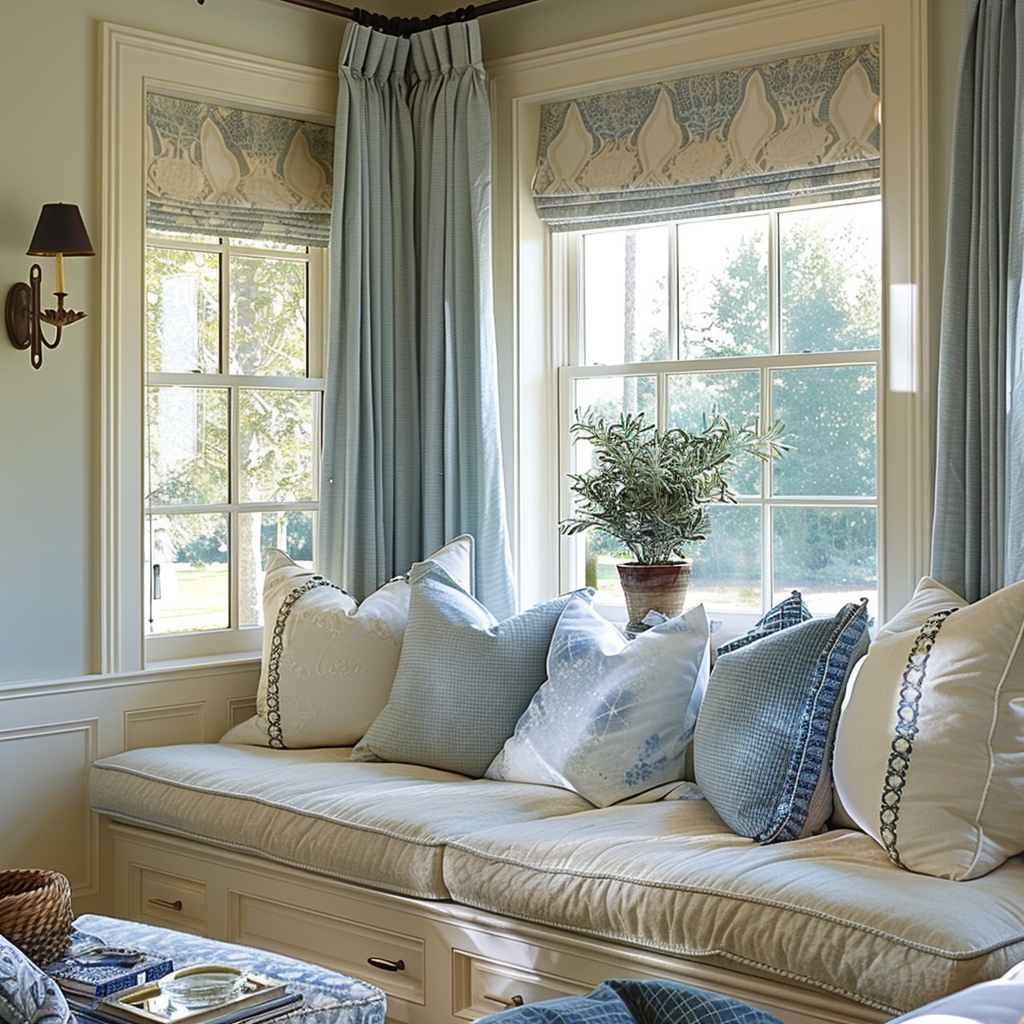
A window seat transforms an often underutilized area into a cozy focal point that eliminates the need for a sofa entirely.
Built-in seating takes advantage of natural light, creating a perfect spot for reading, daydreaming, or watching the world go by.
Adding storage drawers or cabinets underneath maximizes functionality, giving you space to store books, games, or seasonal items.
Custom cushions made from indoor/outdoor fabric can withstand sun exposure without fading while remaining comfortable for extended sitting.
For maximum comfort, choose cushions that are at least 4-5 inches thick with a combination of foam and softer batting on top.
Surrounding your window seat with built-in bookshelves creates a library-like atmosphere perfect for quiet afternoons with a good book.
Window seats work particularly well in bay windows where the angular space naturally creates a conversation area when multiple people sit together.
Add plenty of pillows in various sizes to provide back support and allow for comfortable lounging in different positions.
Consider extending your window seat slightly beyond the window area to create a more substantial seating area that can accommodate more people.
For evening comfort, install sconce lighting on nearby walls or integrate LED lighting under upper shelving for a warm glow.
A window seat gives you front-row views to outdoor scenery while keeping you comfortably inside—perfect for watching thunderstorms or snowfalls.
In warmer climates, a window seat positioned to catch the breeze becomes the most coveted spot in the house during summer months.
Unlike a sofa that sits in the middle of the room, a window seat frees up valuable floor space for traffic flow or other furniture pieces.
This built-in feature adds architectural interest to an otherwise ordinary room while increasing your home’s resale value.
For a multi-functional approach, design the seat at dining table height and add a small table nearby for an alternative dining nook.
Window seats work in virtually any design style, from traditional to ultra-modern, depending on the cushion fabrics and surrounding details you choose.
Chaise Lounges for Old Hollywood Glamour
Chaise lounges bring instant sophistication to a living space while offering the perfect place to fully stretch out and relax.
Unlike a sofa where you’re typically sitting upright, a chaise lounge is specifically designed for reclining in comfort.
Placing two chaises facing each other with a small table between creates an intimate conversation area with a distinctly elegant vibe.
This arrangement works particularly well in rooms with beautiful focal points like fireplaces or large windows, as the open layout preserves sightlines.
For maximum versatility, look for chaises with adjustable backs that can be positioned at different angles depending on your activity.
A single statement chaise in a bold fabric or interesting silhouette can serve as the artistic centerpiece of your living area.
In bedrooms-turned-sitting-rooms, a chaise provides comfortable seating without making the space feel like a traditional living room.
Historically associated with luxury, chaise lounges instantly elevate the perceived value of your space without necessarily costing more than a quality sofa.
The elongated form of a chaise lounge creates strong visual lines that can help direct the eye through your space.
For smaller rooms, choose a chaise with an armrest on only one side to save space while still providing comfortable support.
Add a floor lamp that arcs over the chaise to provide perfect lighting for reading without requiring additional table space.
Unlike sofas that typically have a fixed orientation, many chaises can be approached from either side, giving more flexibility in room arrangements.
A leather chaise develops beautiful patina over time, becoming more attractive and unique as it ages—unlike many fabric sofas.
For homes with elderly family members, the long form of a chaise makes it easier to elevate legs for circulation without needing separate ottomans.
Chaises with storage underneath provide convenient places to keep throws, magazines, or other living room essentials.
The variety of styles available—from sleek mid-century designs to tufted traditional pieces—means there’s a chaise that works with virtually any décor.
Bean Bags and Floor Loungers for Casual Cool
Modern bean bags have evolved far beyond the flimsy versions from childhood—today’s options include structured designs with supportive backs and durable fabrics.
These casual seating options instantly create a laid-back atmosphere that encourages relaxation and informal gathering.
For adult-friendly comfort, look for oversized bean bags at least 4-5 feet in diameter that allow for multiple sitting positions.
Memory foam-filled loungers conform to your body much better than traditional bean bag fillings, providing support where you need it most.
Floor loungers that can be positioned flat or folded into chair shapes offer versatility that traditional sofas can’t match.
These seating options are incredibly lightweight, allowing you to easily rearrange your space for different activities or move them to other rooms.
For movie nights, position several bean bags in a semicircle facing your TV or projector screen for stadium-style seating that everyone will love.
Many modern versions come with removable, washable covers—a huge advantage over sofas when inevitable spills happen.
This casual seating style particularly appeals to teens and young adults, making it perfect for family rooms where younger household members gather.
Create a cohesive look by choosing bean bags in different sizes but similar colors or complementary patterns.
Add a few floor pillows and pouffes to the mix for guests who prefer slightly more structured seating options.
A large, low coffee table in the center of your bean bag arrangement provides a convenient surface for snacks, drinks, and remote controls.
This setup costs significantly less than traditional furniture while often providing more seating capacity in the same amount of floor space.
The informal nature of bean bag seating naturally encourages conversation and connection in a way that more formal furniture arrangements sometimes don’t.
For a more sophisticated take on this casual style, look for leather or structured fabric bean bags with clean lines and neutral colors.
This arrangement works particularly well in bonus rooms, finished basements, or dedicated media rooms where comfort trumps formality.
Hammock or Hanging Chair for Boho Bliss
Installing a hammock or hanging chair indoors creates an unexpected focal point that doubles as the most relaxing seat in the house.
These suspended seating options bring a sense of playfulness and vacation vibes to everyday living spaces.
The gentle swinging motion has been proven to reduce stress and increase relaxation—something no stationary sofa can offer.
A macramé hanging chair adds beautiful texture to your space while providing a cozy nook for reading or listening to music.
For maximum stability, make sure hanging chairs or hammocks are installed into ceiling joists or supported by a sturdy stand designed for indoor use.
Add plenty of pillows and a soft throw blanket to enhance comfort and incorporate your color scheme into these statement pieces.
In rooms with high ceilings, the vertical space occupied by hanging seating draws the eye upward, making the entire room feel larger.
Unlike bulky sofas, hanging chairs and hammocks allow light and air to flow freely through your space, creating a more open atmosphere.
This setup works particularly well in corners that might otherwise go unused, effectively expanding your living area’s functional space.
For a cohesive look, incorporate other natural elements like plants, woven baskets, and wood accents throughout the room.
Hammock chairs that combine the best features of both options provide comfortable seating without requiring as much space as a full hammock.
Add a small side table within arm’s reach to hold books, beverages, or your phone while you relax in your suspended seat.
This unique seating choice becomes an immediate conversation starter when guests visit your home.
For those concerned about permanent installation, free-standing hammock stands and hanging chair frames offer the same experience without modifying your home.
The cocoon-like feeling of being wrapped in a hammock or hanging chair creates a natural retreat space within your larger living area.
This arrangement pairs beautifully with floor cushions or poufs to provide additional seating options when friends gather.
✨Click to Get My 101 FREE Designer Room Ideas
Bench Seating Around the Perimeter
Building bench seating along the walls of your living space maximizes seating capacity while keeping the center of the room open and airy.
This arrangement works particularly well in smaller rooms where a traditional sofa would make the space feel cramped and difficult to navigate.
Built-in benches can incorporate valuable storage underneath, providing hidden places for toys, media, seasonal items, or extra linens.
For comfort, top your benches with cushions at least 3-4 inches thick, covered in durable fabric that complements your décor.
Adding pillows of various sizes along the back edge creates the support and comfort of a sofa without the bulky frame taking up valuable floor space.
This setup naturally creates a more sociable environment, as people face each other rather than all looking in the same direction as with a traditional sofa arrangement.
Bench seating can follow the natural architecture of your room, taking advantage of nooks, alcoves, and awkward corners that standard furniture can’t utilize.
A round or oval coffee table in the center of the room provides a convenient surface while enhancing the communal feeling of this arrangement.
For dining flexibility, select a coffee table with an adjustable height that can be raised for meals and lowered for casual use.
This configuration works beautifully in rooms with stunning views or architectural features, as it doesn’t block sightlines with tall furniture backs.
Built-in benches increase your home’s value, adding custom features that potential buyers see as desirable built-ins rather than furniture that will be removed.
The clean lines of bench seating create a more streamlined, minimalist aesthetic than most sofas, reducing visual clutter in your space.
For maximum flexibility, consider incorporating a few sections with hinged tops for easy access to the storage beneath.
Add power outlets and USB ports at strategic points along your bench seating to create convenient charging stations for devices.
This seating style adapts well to both modern and traditional design schemes depending on the details, materials, and cushion styles you choose.
Unlike a sofa that remains stationary, bench seating becomes part of your home’s architecture, creating a custom space that perfectly suits your lifestyle.
Modular Floor Mattresses for Ultimate Flexibility
Modular floor mattresses (sometimes called folding mattresses or tri-fold mattresses) provide comfortable seating that can be rearranged into countless configurations.
During the day, fold these mattresses to create sofa-like seating arrangements with built-in back support.
For movie nights or lounging, unfold them completely to create a cozy floor-lounging setup that everyone will love.
When overnight guests arrive, these same pieces transform into comfortable sleeping accommodations without requiring any additional furniture.
Choose mattresses with washable covers in colors or patterns that complement your décor for a cohesive look.
For a finished appearance, look for models with attached straps or buttons that help maintain their shape when folded into seating positions.
This arrangement works particularly well in multi-purpose rooms that need to transform from living spaces to guest accommodations quickly.
The lightweight nature of these mattresses means even children can help reconfigure your space for different activities.
Add a few firm bolster pillows to increase comfort and provide additional back support when the mattresses are in their seating configuration.
A large area rug underneath adds warmth and comfort while helping to define your flexible seating area within the larger room.
Unlike traditional furniture, these modular pieces can be easily stored away in closets when you need completely open floor space.
This setup costs significantly less than purchasing both a sofa and a guest bed separately.
For a coordinated look, add a few floor pillows in complementary fabrics that can provide additional casual seating or support.
A collection of low side tables placed strategically around your arrangement provides convenient surfaces for drinks, snacks, or books.
This unconventional approach naturally creates a more relaxed, casual atmosphere that encourages people to kick off their shoes and get comfortable.
The flexibility of modular floor mattresses makes them perfect for families with changing needs or those who frequently rearrange their spaces.
Conversation Pit: Retro Comeback with Style
A conversation pit—a sunken seating area built directly into the floor—creates an instantly intimate gathering space without any traditional furniture needed.
This architectural feature was popular in mid-century homes but is making a stylish comeback in contemporary design for good reason.
The sunken nature of these spaces naturally draws people together and creates a distinct zone for socializing within a larger room.
Built-in bench seating around the perimeter is typically topped with comfortable cushions and plenty of pillows for maximum comfort.
The slightly enclosed feeling of sitting below the main floor level creates a cozy, protected atmosphere that encourages longer conversations.
For flexibility, include power outlets within the pit area for charging devices or adding table lamps for evening ambiance.
A conversation pit works particularly well in open-concept homes, creating definition without blocking sightlines or interrupting flow.
The center of the pit can feature a coffee table, fire feature, or simply be left open for additional floor space when needed.
This arrangement eliminates the awkward “floating furniture” problem that can occur in very large rooms, anchoring the seating area definitively.
For safety, include well-defined steps and consider subtle lighting along the edges to prevent missteps when entering or exiting the pit.
Unlike traditional furniture arrangements that can feel formal, a conversation pit naturally encourages more relaxed postures and casual interaction.
Modern versions often incorporate storage within the bench seating, maximizing the functionality of this unique feature.
This design makes a bold architectural statement that becomes a memorable feature of your home rather than just another furniture arrangement.
Conversation pits work with virtually any design style—from boho with tons of colorful pillows to minimalist with clean lines and neutral cushions.
This setup is particularly ideal for homes that frequently entertain, as it can comfortably seat more people than traditional sofa arrangements in the same square footage.
While requiring more significant construction than simply buying furniture, a conversation pit adds substantial value to your home as a distinctive architectural element.
Gaming Setup with Ergonomic Chairs
A dedicated gaming area with high-quality ergonomic chairs creates a functional living space that prioritizes comfort during long sessions without needing a sofa.
Unlike typical office chairs, gaming chairs are designed for extended sitting periods with features like adjustable lumbar support, headrests, and reclining capabilities.
Arrange several gaming chairs in a semicircle facing your entertainment center to create a setup that’s perfect for both solo and multiplayer gaming.
Add ottomans or footrests to each chair for maximum comfort during marathon gaming sessions.
For a cohesive look, choose gaming chairs in complementary colors that match your room’s color scheme rather than the typical bright racing-inspired designs.
Include side tables between chairs to hold drinks, snacks, and controllers within easy reach of each player.
A large coffee table in the center provides space for board games or tabletop gaming when you want to take a break from screens.
Gaming chairs on wheels allow for easy reconfiguration of your space when switching between different types of games or entertainment.
Add ambient lighting through LED strips behind your TV or monitor to reduce eye strain during evening gaming sessions.
For serious gamers, consider chairs with built-in speakers and vibration features that enhance the immersive experience of gameplay.
This setup naturally creates a more active, engaged environment than the passive lounging typically associated with traditional sofas.
Unlike a sofa where multiple people must share the same piece of furniture, individual gaming chairs give everyone their own personal space.
The ergonomic features of quality gaming chairs provide better support for your back and neck than most sofas, especially during longer sitting sessions.
For a more sophisticated look, explore the growing market of designer gaming chairs that offer the same ergonomic benefits in more subtle, living-room-appropriate styles.
This arrangement works particularly well for families with teenagers or adults who enjoy gaming together regularly.
The individual seating approach makes it easier to add or remove chairs as needed when friends join your gaming sessions.
✨Click to Get My 101 FREE Designer Room Ideas
Floor-to-Ceiling Bookshelves with Reading Nooks
Converting an entire wall to floor-to-ceiling bookshelves with integrated reading nooks eliminates the need for a sofa while creating a stunning focal point.
Built-in bench seating nestled between bookshelves creates cozy reading alcoves where you can surround yourself with your favorite titles.
This arrangement maximizes vertical space in your room while providing both abundant storage and comfortable seating in one cohesive unit.
Top your bench seats with cushions at least 4 inches thick for comfort during extended reading sessions.
Add electrical outlets inside the nooks for reading lamps or charging devices while you lounge with a good book.
The surrounding bookshelves create a naturally cozy, enclosed feeling that many find more comfortable than sitting in the middle of an open room.
For a balanced room layout, place a few comfortable chairs facing the bookshelf wall to create a conversation area that complements the reading nooks.
Install adjustable lighting within each nook to provide perfect illumination for reading without straining your eyes.
This setup naturally encourages a more mindful living room environment focused on reading and conversation rather than television watching.
Built-in bookshelves with seating add significant value to your home as a custom architectural feature that many buyers find highly desirable.
The combination of open shelving and enclosed cabinet space below the seating provides storage for everything from books to board games and media.
For a cohesive look, paint the entire unit—shelves, cabinets, and bench frames—the same color as your walls to create a seamless built-in appearance.
This arrangement works in virtually any size room—in smaller spaces, a single reading nook can replace a sofa, while larger rooms might include multiple nooks.
Unlike a sofa that can only be arranged in certain ways due to its size and shape, built-in seating conforms to your specific space.
Add curtains that can be drawn across individual nooks to create private reading retreats when multiple people are using the room.
This living room solution brilliantly combines functionality, storage, and comfort while creating a distinctive space that reflects a love of books and learning.
Lounge Chairs

Swap out the sofa for two or three lounge chairs instead.
Position them around a rug or coffee table to create an intimate seating area that still feels cohesive.
Look for lounge chairs with unique silhouettes or materials to add visual interest.
Tufted leather chairs, for example, will add richness and texture.
For a bit of glamour, opt for lounge chairs with brass or gold accents.

Make sure to leave enough room between chairs so that the space doesn’t feel too crowded or awkward.
Add in side tables for holding drinks and lamps for ambiance.
A lived-in look can be achieved by layering plush throw blankets over the chairs.
Bench Seating
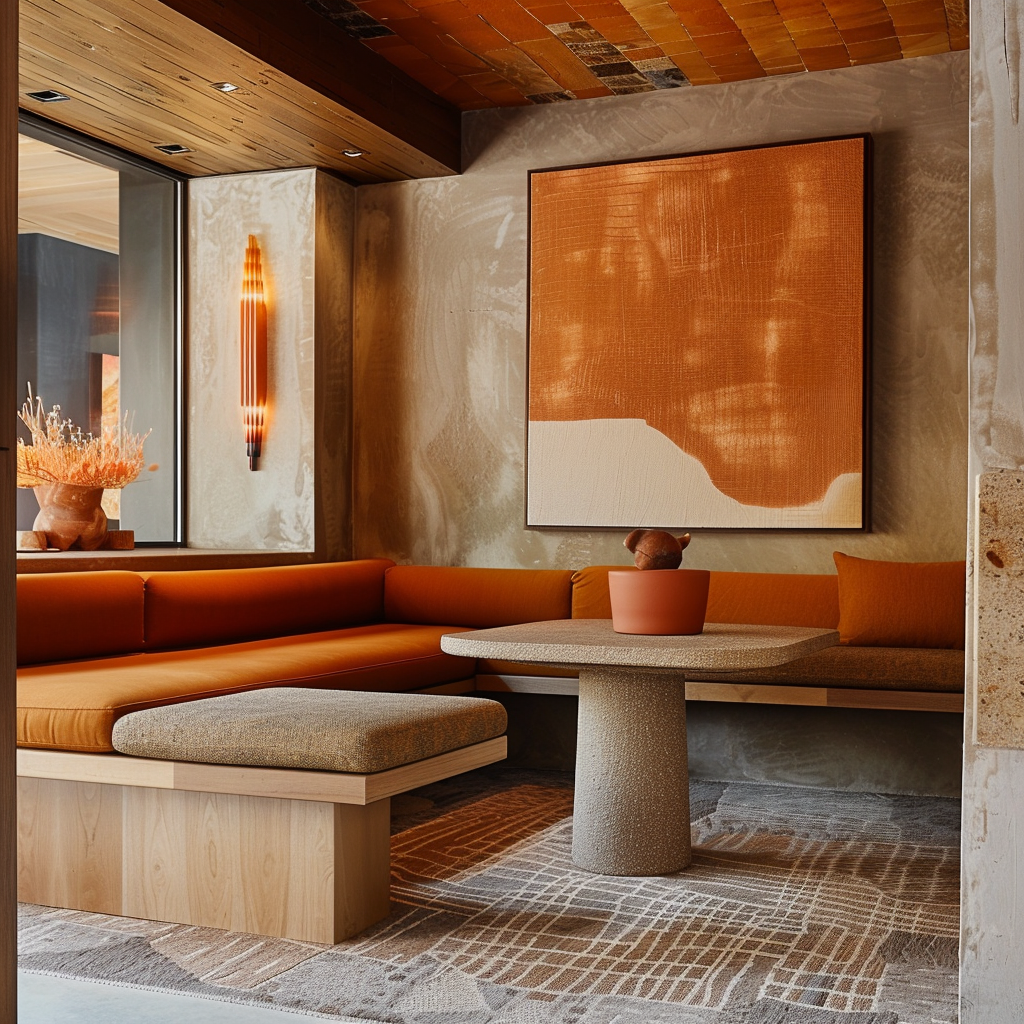
Benches are an intriguing alternative to sofas, especially for smaller living rooms.
Opt for two matching benches facing each other, using the coffee table in between to connect them.
This creates a conversational seating area with a more open and airy feel than bulky sofa.
Bench seating also lends itself well to a breakfast nook concept.
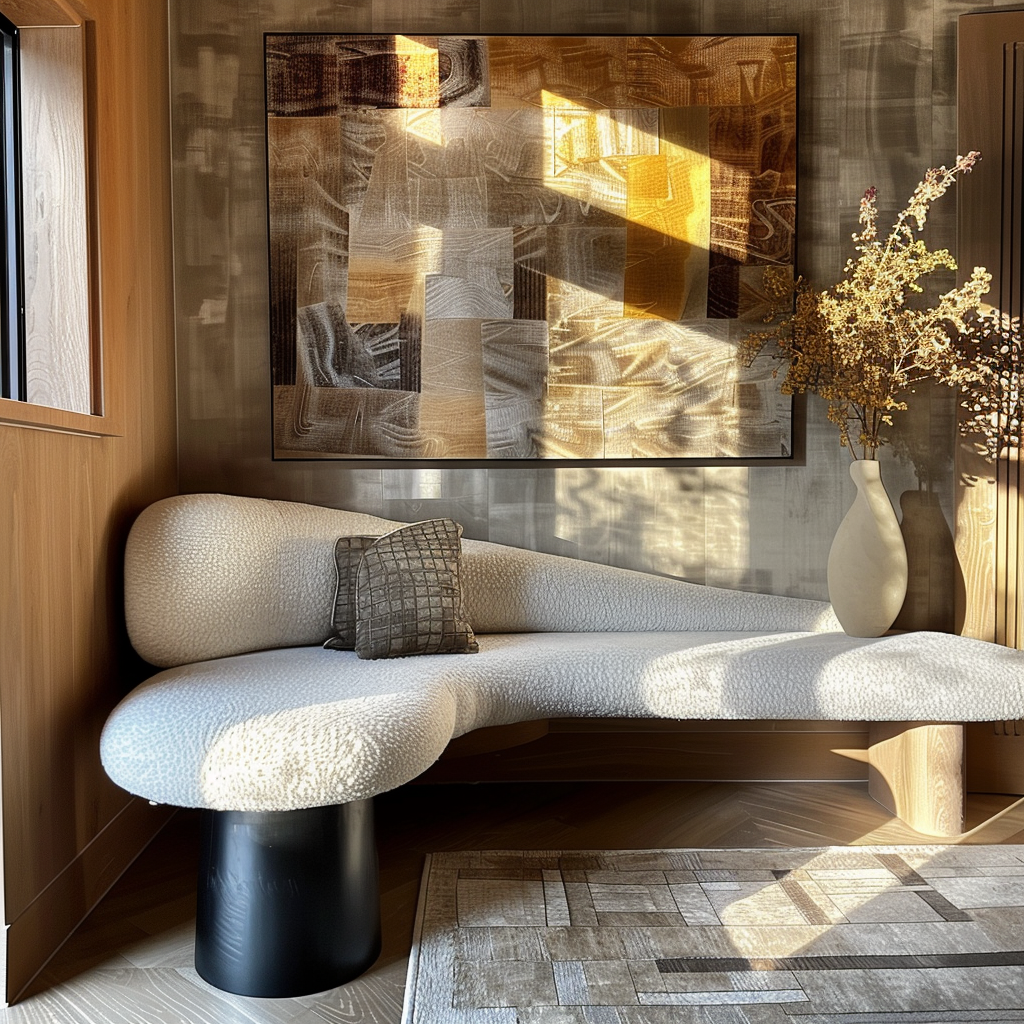
Place a round dining table between two bench seats for an eat-in dining space that doubles as living room seating when not eating.
Top the benches with patterned throw pillows for comfort and style.
Upholstered benches will create a chic, luxurious vibe, while wood benches make for a more casual, farmhouse aesthetic.
If you have bay windows or other architectural focal points, position benches perpendicular to the windows to enjoy the views.
Statement Chairs
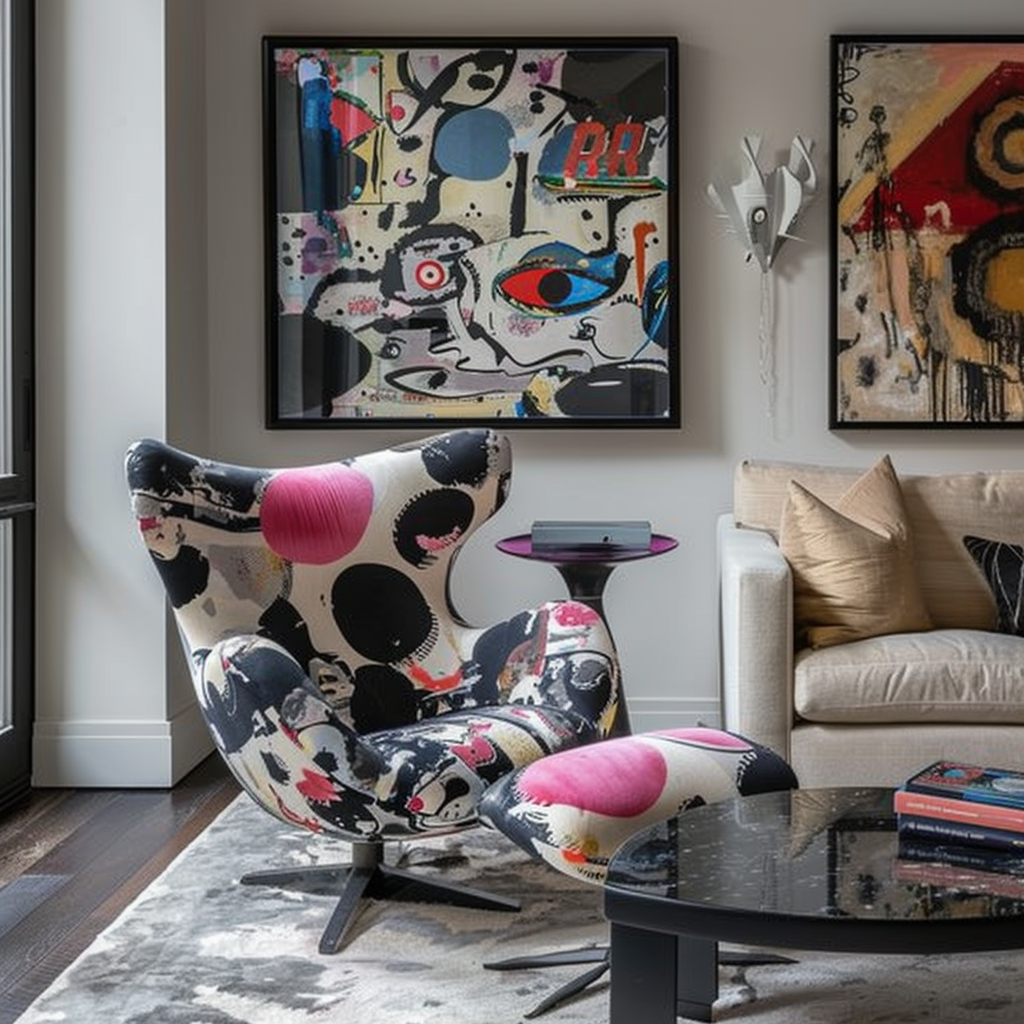
In lieu of a sofa, use statement chairs as the stars of the living room.
This is a great opportunity to select chairs with striking silhouettes, fabrics or colors to create a visual focal point.
A pair of blue velvet chairs or chairs with a unique shape like a sloped silhouette or cut-out back will command attention.
Complement them with decor that enhances their look – like circular end tables that echo a round chair shape.
Place chairs across from each other to design a conversational seating arrangement, turning the chairs inward to face each other.
Or, position two chairs at either end of a console table against the wall as another alternative.
Make sure to leave enough walking room around the chairs so the space doesn’t feel cluttered.
The chairs will feel like sculpture and artwork combined.
✨Click to Get My 101 FREE Designer Room Ideas
Reading Nook

Carve out a special reading nook with a comfy chair or two floated in the corner.
This creates an intimate space designed for getting cozy with a book, while keeping the rest of the living room open.
Choose chairs with a relatively small footprint like a slipper chair or armchair.
Face the chairs toward the corner and place a side table in between to hold books, snacks and drinks.
You can delimit the space with a small area rug underneath and accent lighting above, such as a swing arm sconce.
Add personal touches like a blanket, footstool and floor pillows to make it extra inviting.
The reading nook will feel like a special little gem tucked away within the larger living room.
Oversized Chair
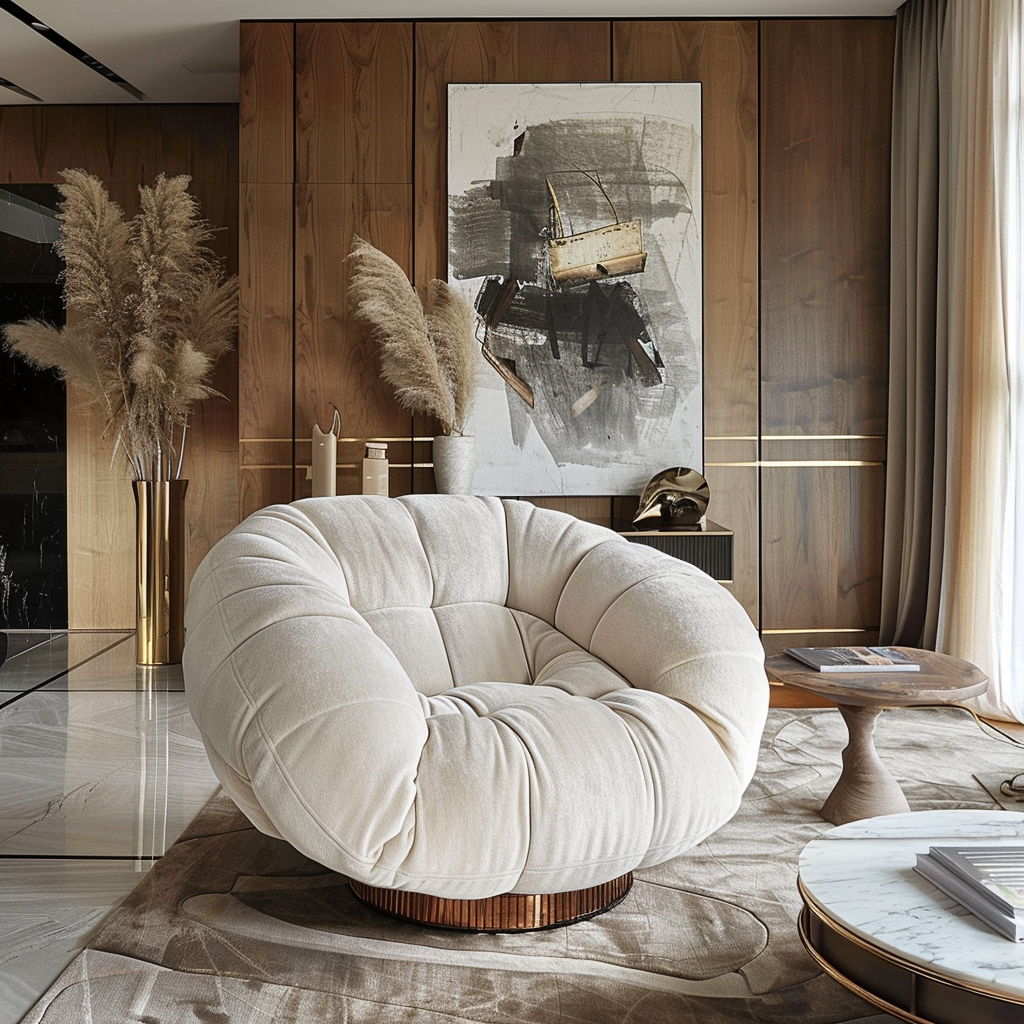
Make a substantial armchair or slipper chair the star in your living room vignette.
An oversized chair makes a bold statement and serves as a chic alternative to a sofa.
Choose a chair with a unique shape, luxurious fabric, eye-catching prints or ornate details to imbue it with style and presence.
Flank the chair with end tables to create ample surface space for lamps, table books and beverages.
Position the oversized chair near other focal points like a fireplace or large window to enhance the vignette.
Angle it slightly toward the other elements.
The oversized scale offers as much seating real estate as a loveseat, allowing you to curl up comfortably.
Layer in accent pillows and blankets for additional visual interest and coziness.
The chair will feel like a throne anchoring the space.
Ottomans
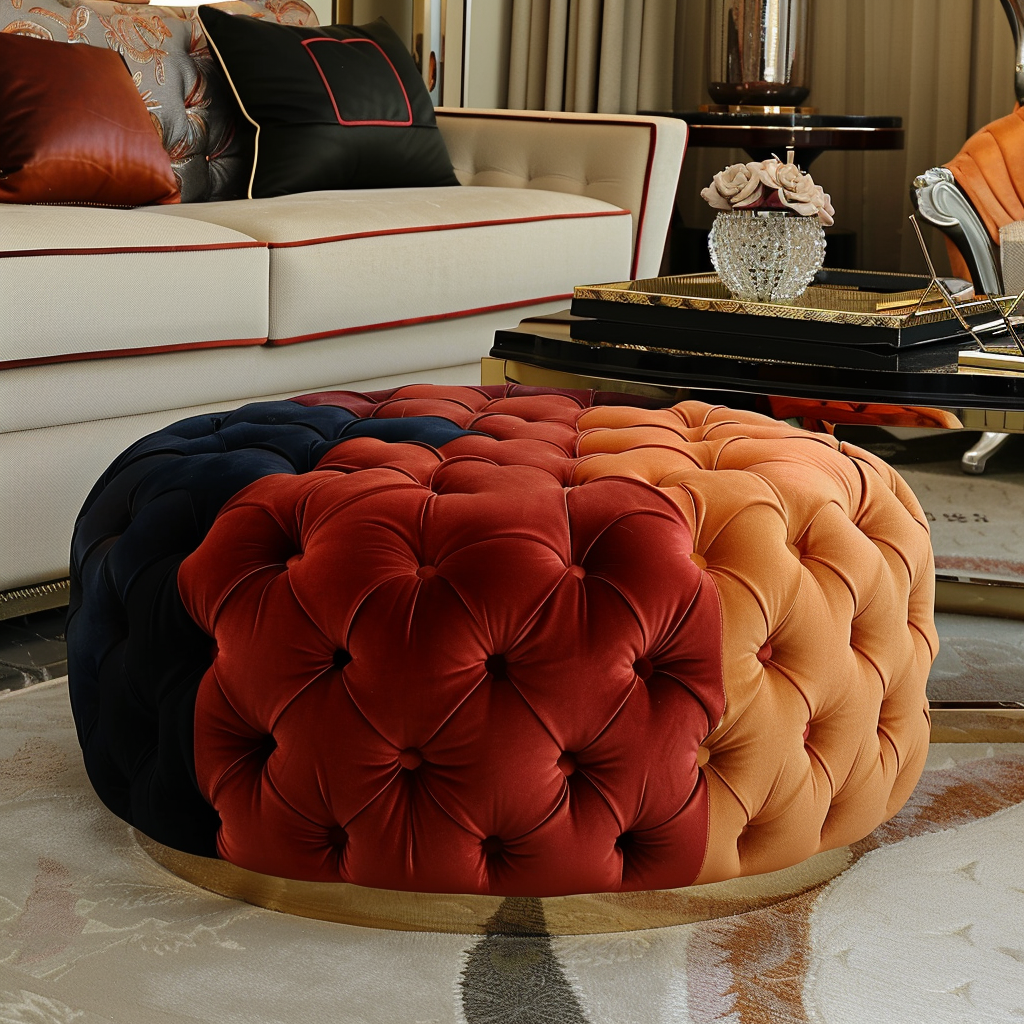
Scatter a trio of ottomans around a coffee table to fashion a laid-back seating area.
Round or square ottomans work well for flexibility in arranging an open grouping.
Make sure they are large enough to function as comfortable seats rather than just footstools.
Consider nesting tables with removable tops to create ottoman and table combinations.
Add throw blankets on top for extra coziness and lushness.
Play with different heights and silhouettes – pairing a circular pouf with a square leather ottoman, for instance.
Just be sure to leave enough room between pieces so that the space doesn’t get crowded.
Add an area rug underneath to delineate the ottoman seating area.
The casual vibe is perfect for entertaining or lounging with family.
You can pull pieces out to create unique configurations or move them against the wall as auxiliary seating when needed.

